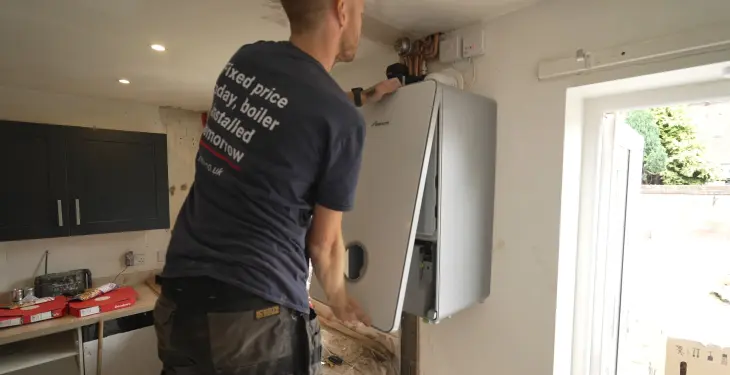



Written by Stephen Day
Gas Safe Engineer
Updated: 30th May, 2025
Different appliances in your home use various amounts of electricity. Understanding this can help you manage energy costs
Get a new boiler quote, save up to £550 per year (0% APR available).
Trying to understand how much energy your household appliances use can greatly influence your electricity bills. Homeowners might be surprised to learn that some common gadgets consume more power than they think. This knowledge can help anyone make better energy choices at home.
The truth is, many everyday appliances and gadgets use more electricity than expected, significantly impacting your energy costs.
Different appliances around the house contribute differently to your electricity usage. For instance, while microwaves and TVs are often used, they consume power at varying rates. Plasma TVs, for example, can use a lot more electricity compared to standard LCD models. Moreover, simple tasks like boiling a kettle or doing laundry may seem insignificant, but they add up over time.
Understanding the energy usage can lead to savings on your monthly electricity bill. Identifying which appliances drain the most power helps in making informed decisions.
Exploring the real energy usage of household items can open eyes to more efficient practices and potentially lead to a more environmentally friendly lifestyle.
Get a quote in 60 seconds, fitted as fast as next day!
0% APR finance available.
Different appliances in your home use various amounts of electricity. Understanding this can help you manage energy costs.
These appliances run continuously, using about 200 to 800 kWh per year depending on the model’s size and efficiency. Investing in an energy-efficient model can reduce costs.
An electric oven typically uses around 2-2.5 kWh per hour of operation. Over the year, this can add up significantly, especially if used frequently.
These can consume 1 to 1.5 kWh per cycle. Energy-efficient models usually use less water and electricity, making them a better choice for saving on utility bills.
Using less energy than ovens, microwaves consume about 0.8 kWh per hour. For quicker meals, they can be a cost-effective alternative.
Additionally, consider energy-saving practices. Turning off appliances when not in use and using eco-modes can make a big difference.
Each appliance varies, so it's worth checking energy ratings and usage on each device. By being informed, households can better manage their electricity consumption and reduce expenses.
Certain gadgets in the home are known for consuming more power than others. Understanding this can help manage energy costs. Key gadgets include washing machines, TVs, and air fryers.
Washing machines, for instance, often use around 4.5 kWh per hour-long cycle. This translates to significant energy usage, especially with frequent washes.
Televisions also vary in power usage. A standard LCD TV consumes about 120 watts, costing a modest amount to run each hour. Plasma TVs can draw up to 350 watts, which increases running costs.
An air fryer is a handy kitchen appliance known for being more energy-efficient than traditional ovens. It typically requires less time to cook meals, cutting down on electricity use.
Table of Estimated Power Usage:
Appliance | Average Power Usage |
Tumble dryer | 2.60W (standby mode) |
Oven | 2,000-5,000 watts |
Dehumidifier | 300-700 watts |
Dehumidifiers, useful for reducing indoor humidity, use a reasonable amount of power, usually between 300 and 700 watts. Depending on the model and capacity, the power usage can vary, impacting electricity bills.
Understanding these gadgets' energy consumption helps in making informed choices about usage, ultimately aiding in energy conservation and cost savings.
A desktop computer typically uses between 60 and 250 watts of power. This variation is due to factors such as computer components and usage.
To calculate electricity costs, first identify how long the computer operates each day. For example, a desktop running for 8 hours daily might consume about 146 kilowatt-hours (kWh) per year.
The price of electricity can vary based on location and time of day. As an example, if the average cost of electricity is £0.12 per kWh, then you can estimate the cost by multiplying the total kWh consumed by this rate.
Example Calculation:
Daily use: 8 hours
Power draw: 100 watts (0.1 kW)
Daily consumption: 0.1 kW * 8 hours = 0.8 kWh
Yearly consumption: 0.8 kWh * 365 days = 292 kWh
Cost per year: 292 kWh * £0.12 = £35.04
For precise results, you might use a power meter to check the actual watts your computer uses.
Understanding these costs helps in budgeting and highlights potential savings by using energy-efficient components.
Laptops are a common electronic device that many rely on daily. Understanding their electricity usage helps in managing energy costs effectively. On average, laptops consume between 15 and 60 watts per hour.
Factors affecting laptop energy use:
Model and specifications: More powerful laptops with bigger screens and high-performance processors tend to use more energy.
Usage patterns: Continuous heavy tasks like gaming or video editing increase power consumption.
Power settings: Laptops in power-saving mode consume less electricity.
Daily usage example:
A laptop using 50 watts per hour, operated for 8 hours a day, uses about 400 watts daily.To calculate the daily cost, multiply the total watts used by the electricity rate. For instance, if the electricity rate is 20 pence per kilowatt-hour, a 400-watt usage equals 8 pence per day.
Energy-saving tips:
Use the sleep or hibernate mode during breaks.
Adjust screen brightness to a comfortable, lower level.
Turn off unused peripherals.
Applying these tips can reduce how much electricity your laptop uses each day, potentially lowering your energy bills.
Power: 3 kW
Time: 3 minutes (0.05 hours)
Energy Used:
3 kW × 0.05 hours = 0.15 kWh
At 34p per kWh, boiling 1 litre costs about 5.1 pence. Boiling only the amount needed can save energy.
Using a microwave can be a quick way to cook or heat food, but it also consumes electricity. The power cost depends on factors like wattage and how often it's used. A typical microwave ranges from 600 to 1500 watts. Higher wattage models cook faster but use more electricity.
To estimate the cost of running a microwave, a simple formula can be used:Cost = (Wattage / 1000) × Hours used × Energy rate
For example, with an energy rate of £0.29 per kWh, an 800-watt microwave running for 1 hour costs around 23p.
Microwave Wattage | Energy Cost per Hour |
700 watts | ~20p |
800 watts | ~23p |
1000 watts | ~29p |
Consider usage habits. Frequent use leads to more energy consumption. For occasional use, the cost remains low, making it an efficient choice for quick meals.
Understanding your device’s specific wattage is key to calculating accurate costs.
Big screen TVs are popular for their impressive display and features. However, they can consume a significant amount of electricity. The amount of power they use depends on the TV's size and technology.
A 55-inch LED TV typically uses about 103 kWh over 1,000 hours of viewing. In comparison, a 55-inch QLED TV uses around 77 kWh for the same viewing time.
Energy costs vary based on the rate charged per kWh. For instance, at 27p per kWh, running a 55-inch LED TV might cost about £25.75 for 1,000 hours. A 55-inch QLED TV could cost roughly £19.25.
Larger TVs tend to use more power. A 75-inch LED TV might consume around 171 kWh over 1,000 hours, making it more expensive to run.
Technology also affects electricity use. OLED displays often use less power because they don't need a backlight, unlike LEDs, which have an extra layer of bulbs.
The actual electricity cost can be calculated by using a TV energy calculator. This tool helps users input their TV's details and estimate usage based on personal habits.
Choosing energy-efficient models can reduce electricity usage and lower bills. Energy ratings provide insight into how efficient a TV is. Selecting a model with a high energy rating can lead to savings over time.
Lightbulbs are common in every home, and their energy consumption is worth considering. Understanding how much power they use can help manage electricity bills.
Types of Lightbulbs and Their Power Usage:
Incandescent Bulbs: Typically use between 25 and 100 watts.
LED Bulbs: Use much less, ranging from 2 to 18 watts.
CFL Bulbs: Usually consume around 8 to 40 watts.
Different types of lightbulbs have vastly different energy requirements.
Voltage and Amperage:
Most household lightbulbs operate at around 110 volts. They draw less than 1 amp in most cases.
Example Calculation:
To calculate the electricity usage of a lightbulb in kilowatt-hours (kWh), you can use a straightforward formula. For example, a 60-watt bulb left on for 5 hours consumes:
60 W × 5 hours = 300 watt-hours = 0.3 kWh
This means it uses 0.3 kWh of energy.
The amount of energy used depends on the wattage and how long the bulb is on. Switching to lower-wattage bulbs, like LEDs, for the same brightness can save energy and lower costs over time.
Impact on Energy Costs:
With the current energy price cap at 22.36p per kWh, using efficient lightbulbs can lead to significant cost savings over time. For example, keep in mind that ten 100W incandescent bulbs will use 1 kW in an hour.
Making informed choices about lightbulbs can reduce energy usage and lower electricity bills, helping to make homes more energy-efficient.
Running costs for a tumble dryer can vary based on the type. The three main types are vented, condenser, and heat pump.
Vented tumble dryers typically cost the most to run. They have average yearly costs of around £138.90. Per cycle, users might spend £1.54. Despite being cheaper to purchase, their operational expense can add up.
Condenser tumble dryers are slightly more efficient than vented dryers. They can cost about £127 annually. Average costs per cycle might be around £1.20 to £1.51, depending on the model.
Heat pump dryers are the most energy-efficient. They work by reusing hot air. While the upfront cost can be higher, they usually cost about 63p per cycle and around £65 to £75 yearly. This makes them a popular choice for those looking to save on energy bills.
Using a tumble dryer twice a week can help determine annual costs based on these figures. Understanding these differences can aid in choosing the right type for your needs and budget.
A washing machine's energy use can vary based on factors like model, efficiency, and cycle settings. On average, a standard washing machine uses about 0.793 kWh of energy per load. This can cost around 19p per cycle, given an electricity rate of 24.5p per kWh.
Modern washing machines are designed to be more energy-efficient. A-rated models can use less energy than older ones. The energy consumption of highly efficient machines can be as low as 250 to 300 watts per hour.
Older or less efficient machines can use up to 2,100 watts per hour. Machines with additional dryer functions typically require more electricity, particularly during the drying phase.
Different washing settings, such as load size and cycle type, significantly affect energy consumption. For example, a heavy-duty cycle tends to use more power than a standard wash.
Here's a quick comparison of energy use:
Model Type | Energy Use per Load |
Standard | 0.793 kWh |
A-rated | 250-300 watts/hour |
Older Models | Up to 2,100 watts/hour |
Understanding these variations helps users choose efficient washing practices, potentially saving energy and reducing costs.
Finding out how much energy household appliances use is simple. Start by noting the wattage of the appliance, which is usually displayed on a label or in the user manual.
To calculate the energy use in kilowatt-hours (kWh), use this formula:
Energy Consumption (kWh) = (Wattage (W) × Hours Used per Day) ÷ 1,000
For example, if an appliance uses 500 watts and operates for 3 hours a day, it consumes:
(500 W × 3 hours) ÷ 1,000 = 1.5 kWh
Understanding this helps identify which appliances consume more electricity and can guide decisions on energy-efficient appliances.
Tips for Saving Energy:
Use energy-efficient models: Look for appliances with high efficiency ratings.
Limit usage time: Reduce the number of hours each appliance is used.
Unplug appliances: Devices in standby mode continue to draw power.
An energy calculator can simplify this process, providing estimated costs and usage based on your data input. Adjusting habits based on this information can lead to significant energy savings.
Using this knowledge helps manage household energy consumption effectively.
Understanding how much it costs to run your appliances can help you manage electricity bills more effectively. By doing so, you may even reduce your overall energy usage.
Start by identifying the wattage of each appliance, which is usually found on their labels. Multiply this by the number of hours the appliance is used daily.
Next, convert the wattage into kilowatt-hours (kWh). Divide the total wattage by 1,000. This gives you the energy consumption in kWh.
To calculate the electricity cost, multiply the kWh by your unit rate. This rate is shown on your electricity bill. An energy cost calculator can simplify this process.
Example:
Appliance | Wattage | Hours Used Daily | Energy Cost (kWh) |
Toaster | 800 | 0.25 | £0.05 |
Awareness of the energy price cap is important. It affects how much you pay per kWh. Adjust your calculations if there's a change in the cap.
Being mindful of energy habits adds up to savings. Turning off appliances when not in use and using more energy-efficient models can help reduce running costs.
By adopting these measures, they can better manage their energy expenses and contribute to reducing overall consumption.
Household appliances are essential but can significantly impact energy bills.
Washing Machines, Dishwashers, and Tumble Dryers: These appliances are major electricity users. They account for around 14% of an average energy bill due to the energy needed to heat water.
Refrigerator and Freezer: As they run all day, they have a constant draw of power. Energy-efficient models can lower consumption, reducing the carbon footprint.
Televisions and Home Entertainment Systems: These devices often run for long hours. Larger screens and additional features can increase their energy use.
Ovens and Stoves: Cooking requires considerable electricity, especially in appliances with energy-intensive features like self-cleaning.
Computers and Gaming Consoles: They are used for work, play, and often run for extended periods.
A programmable thermostat can help manage heating and cooling, potentially lowering energy costs associated with heaters and air conditioners.
Using a combination of these devices wisely can reduce electricity use. Unplugging electrical devices when not needed and opting for energy-efficient appliances can also lead to savings.
Using power ratings found on the labels of appliances, you can estimate energy usage. This helps spot the biggest electricity consumers. Understanding these key appliances can lead to informed energy-saving choices.
Get a quote in 60 seconds, fitted as fast as next day!
0% APR finance available.
Last updated: 30th May, 2025

Written by Stephen Day
Gas Safe Engineer at iHeat
Stephen Day is a Gas Safe registered and FGAS certified engineer with over 20 years of hands-on experience in the heating, cooling, and renewable energy industry, specialising in boiler installations, air conditioning, and heat pump systems.
LinkedInArticles by Stephen Day are reviewed by iHeat’s technical team to ensure accuracy and reliability.

22nd December, 2025
Based on data from over 7000 boiler installations completed by iHeat in the past 12 months...
 Read Article
Read Article

22nd December, 2025
Here’s a quick roundup of the best combi boilers for 2026.
 Read Article
Read Article

22nd December, 2025
When your old boiler breaks down and it comes time to replace it with a new one, it might...
 Read Article
Read Article
No obligation. Takes less than 60 seconds.